Research Article
ATTITUDES OF RESTAURANT OWNERS ABOUT MODERN TRENDS IN GASTRONOMY AND FUTURE DIRECTIONS FOR BUSINESS IMPROVEMENT
3821
Views & Citations2821
Likes & Shares
ABSTRACT
This paper will present the results of the research that was conducted in order to examine the attitudes of restaurant owners about the modern trends in gastronomy and to discover some future directions for business promotion. 73 respondents participated in the research and answered the survey questionnaire. By analyzing the obtained answers, a conclusion that was reached is that respondents generally follow gastronomic trends, but cannot single out the interest of visitors for a certain type of cuisine in their restaurants. Most respondents are willing to adjust their menu to new trends and challenges, and it has shown that a large number of visitors in their facilities are satisfied with the gastronomic offer. A positive outcome was also obtained when it comes to employee training staff on the origin, composition and nutritional value of meals, cooperation with local producers. Most respondents also believe that the profit of their restaurant has not increased significantly after the introduction of new dishes, but all respondents are unanimous when it comes to promoting their services through social media networks. The result that must be especially emphasized is the one which showed that the largest number of respondents plan to invest in the development of their restaurants by introducing innovations to the menu and working on constant improvement of the kitchen, nurturing communication with guests and aligning the offer with their wishes and needs, and that is precisely the essence of the hospitality business: that the consumer and his/her pleasure be the center of attention.
Key words: Modern trends, Gastronomy, Innovations, Business improvement, Restaurants, Guests
INTRODUCTION
The business of economic entities in the field of restaurants and gastronomy and their position in the tourism market is directly related to international tourism. Trends in international tourism will cause significant changes in the business orientation of the hospitality business (Barjaktarović & Knežević, 2015).
According to (Bakan, 2015) gastronomy and new gastronomic trends are becoming an increasingly important factor in shaping specific tourist experiences. Although gastronomy is an integral part of every tourist trip, i.e., visits to certain destinations, special tourist products based on gastronomic heritage or new, popular trends in gastronomy are increasingly becoming the main motives for special segments of tourists, there are also tourists whose main motive is gastronomy.
Today's consumers, who are more educated and more demanding, follow new trends and justifiably expect that the owners of catering facilities will follow the trends and enrich their menus with dishes that follow current gastronomic trends. Today, gastronomy is closely related to health care, preservation of tradition and authenticity (Bakan, 2015).
Modern tourism has undergone great changes in both qualitative and quantitative terms. The focus is on the consumer, to whom the tourist offer is constantly adapting. The modern tourist is a highly demanding consumer of tourist services. He is a well-informed person, who sees in tourist trips not only rest and fun, but also the opportunity to learn something new. As a consequence of changes in tourist demand, there is an affirmation of new, selective forms of tourist traffic, which have a tendency of constant growth. It is necessary to pay more attention to these forms of tourism when forming the tourist offer of destinations. Some of them include a clientele that is characterized by a high discretionary income and thus enable the realization of a high object, although they imply a smaller volume of tourist traffic (Damjanović & Ristić, 2017).
LITERATURE REVIEW
As food is a universal language, it transcends race, ethnicity, gender, sexuality, age and class. It also talks about tradition, culture and identity. He even invites people into the community. Aside from its essential nature, food has evolved into something else. Far from its roots, food or gastronomy has developed as an emerging phenomenon and has become one of the significant tourism products and continues to contribute to economic growth everywhere in the world (Socha Dietrich & Dumont, 2021). Gone are the days when a man was satisfied with basic needs: food, shelter and security (Socha Dietrich & Dumont, 2021).
As stated by (Mak et al., 2012). man is in a constant search for overall well-being and satisfaction, therefore, the emergence of new preferences. This evolution of preferences is a multiplier for all industries and sectors.
Nowadays, there is a growing interest in high-quality products for which consumers are willing to pay a higher price. Consumers also appreciate authentic food that has significant quality. Guests are increasingly paying attention to the portion size, composition and nutritional value of the food they consume outside the home, and the desire for new flavors is becoming increasingly attractive (Krešić, 2012).
The lifestyle has changed a lot in recent years. Large quantities of food are no longer, as they used to be, synonymous with an attractive catering offer. It must now be light, tasty, varied and visually appealing. Along with gastronomic expectations, the technology in the kitchen is also changing. According to the changed requirements, the importance of food is no less than before - people are still able to spend more money and even travel for hours due to quality food, top service and ambience, but also even better promotion of the catering facility. All this is a new form of successful restaurants, which, thanks to their quality of success, creative staff and new technology in the kitchen, thanks to which the boldest gastronomic ideas are much easier to implement today. Following trends and changes in the way more and more demanding guests are served is key to successful business in an increasingly competitive market. Competitive advantage is increasingly becoming a way and speed in dealing with guests (Drpić & Vukman, 2014).
It is very important to meet the needs of the customer and respect all services in order to create value (Jahan et al., 2020). According to (Božić & Đurović, 2019). modern trends in the hospitality industry are focused on various aspects, including trends in the field of gastronomy, which are most noticeable to service users. One of the most interesting modern trends in gastronomy is molecular gastronomy. This modern trend in restaurant business, which is very complex and insufficiently known to the general public due to the fact that it is a relatively new direction in food preparation in restaurants, is striving to include more and more new trends in the tourist offer.
New gastronomic trends are becoming an increasingly important factor in shaping tourist experiences. It can be said that gastronomy is an integral part of every tourist trip, i.e., going to certain destinations, but special tourist products are based on gastronomic heritage and are increasingly becoming a motive for travel as important segments for tourists when going to a particular destination (Bakan, 2015). (Janković et al., 2020).
Gastroenology is a special branch of tourism, but at the same time a complex gastronomic discipline, as evidenced by the possibility of creating different combinations of food and wine (Tešanović, 2016). Trends in eno-gastronomy play an important role in the strategic development of the new concept of tourism. The concept includes gastronomic offer, agritourism, wine routes (Wine days), etc., as an integrally recognizable tourist product. Food in the broadest sense (eating and drinking) contributes to the attractiveness of every tourist destination (Damjanović & Ristić, 2017).
Moreover, gastronomy, as an integral part of tourism, (Gordin et al., 2016), also noted that it has advanced with ways of preparing meals and scientific processes in including various food trends. The trend in gastronomy has shifted 360 degrees as observed; there is a growing demand for more natural and environmentally friendly gastronomic products. In addition to the priorities of today's gastronomy, the culture behind food expands the offer of delicious, tasty, aromatic, but healthy, processed products with low tones, organic and environmentally friendly products (Organic Authority, n.d.). Innovation in gastronomic products is considered one of the most important factors of success in markets of this type (Vargas Sánchez & Lopez Guzman, 2015).
Modern trends in the hospitality industry are focused on several key issues, namely: business in accordance with the concept of sustainability, energy efficiency and use of renewable energy sources, "green" business, "green" and eco certification, environmental protection, waste reduction and promotion healthy eating (Božić & Đurović, 2019).
Food consumption is the most important form of consumption, but it is largely neglected in the literature on hospitality and tourism. So far, no research on this topic has been conducted in the Republic of Serbia, but only research that includes examining the quality of hotels. The position of the wine on the list or menu also affects the sale of wine. Food and drinks are sometimes presented in two different menus or one after the other (Terrier & Jaquinet 2016).
In modern gastronomy, there are several trends that can be considered challenges for the current restaurant business model. It is presented in several sections through food consumption and dining: Development of food services in shopping malls, the growing role of street food, the emergence of the function of the dining room in new public spaces (parks, coastal areas) and increasing the popularity of home delivery of meals (which is largely influenced by new technologies in the IT sector) (Kowalczyk, 2020).
Consumer behavior is diverse according to their attitudes that are heavily influenced by megatrends. For the next ten years, it will be health, practicality and satisfaction. The strongest of them is health, from which most current trends in nutrition arise. There has been an increase in awareness of food for human health, personalized nutrition, protection of food authenticity, consumption of organically grown food, which is related to the values of sustainable development (Rojo et al., 2012).
Restaurant companies have the task of primarily satisfying the nutritional needs of people, and on the other hand they aim to satisfy the needs of socialization, where guests come to socialize, be in a different environment and try new flavors that are not prepared in their homes. This obliges restaurants to introduce changes in order to attract guests and to follow world gastronomic trends. The catering industry is rapidly developing and introducing innovations in the processes of services it produces, and in order to increase customer loyalty and be competitive in the catering and tourism market, it must follow the trends of modern gastronomy (Obrenović et al., 2019).
Food tourism is a growing phenomenon, with a special emphasis on experiencing authentic and traditional local food, which provides local producers and service providers with a means to develop regional identity, improve environmental awareness and preserve traditional lifestyles (Birch & Memery, 2020).
We can define organic agriculture through its goal, which is the production of healthy food based on sustainable development. One of the important factors related to the development of organic agriculture is the education of staff (Tasić, 2018).
The quality of food in the context of this paper refers to the way of growing the food that is used, as well as the nutritional values that they contain. Through the analysis of each show, attention was drawn to the importance of a healthy diet and the preparation of meals that include rich, organic foods. Organic food, as a product of plant production, in agriculture is the result of the work of exclusively living organisms, i.e., green plants (Kisić, 2014).
Consumers' personal knowledge, personal preferences, attitudes and beliefs about food and nutrition have a great influence on the adoption of dietary habits. Consumer attitudes toward food are influenced by beliefs about what makes them healthy, their own views on an individual's ability to take control of themselves alive, primarily because of eating habits and health problems and the role of the media based on articles published on food (International Food Information Council) (Skryl et al., 2018).
WORK METHODOLOGY
When compiling the questionnaire, care was taken to cover the most important aspects of the attitudes of the owners of catering facilities. In this context, the statements in the questionnaire were conceived in order to measure the attitudes of restaurant owners about current trends in gastronomy and future directions for better business.
The research was conducted in the period from March 20, 2020. to 01.05.2020. years. 73 respondents participated in the research.
The questionnaire was created based on the research they conducted (Bakan, 2015; Dugi, 2017; Drljević, 2016). with certain modifications related to the research topic.
The questionnaire is designed to interview restaurant owners about current trends in gastronomy and future directions for business improvement.
SURVEY QUESTIONNAIRE
The survey questionnaire consists of two thematic parts. The first part of the survey measures the socio-demographic characteristics of restaurant owners and basic information about the restaurant, i.e.: gender, age, forms of education of employees, name of the facility, how many catering facilities there are, what type of restaurant it belongs to. The second part refers to the owners 'attitudes to modern trends in gastronomy, i.e.: the extent to which they follow the latest trends, whether there is interest in other types of cuisine, the owner's willingness to adjust the menu to new trends, comments on guests' reactions to new dishes; menu, whether the staff employed is sufficiently trained on the origin and chemical composition of food, whether they cooperate with local producers, whether there are differences in the price of new and standard dishes, whether the introduction of new dishes increased profits, what percentage are regular guests , what is the structure of the guests, which marketing activities are carried out in order to improve the work, the ocean of business of the facility and future directions for the introduction of novelties in the restaurant.
METHODS OF WORK
The content of the research also determines the application of appropriate methods. The results of the research will be obtained:
-using various domestic and foreign literary sources - desc resrch;
-interviewing / telephone and email address (survey questionnaire);
-statistical methods (data analysis will be performed by the software package SPSS 22) (SPSS, 2013).
STATISTICAL DATA PROCESSING
SPSS for Windows 20, which runs under the Microsoft Windows environment, was used for data processing. The results are presented graphically and tabularly. In order to determine the differences between the respondents by gender in terms of assessing the restaurant business, a t-test for independent samples was used. In order to compare the respondents by age in terms of assessing the restaurant business, a one-factor analysis of variance was used. In order to examine the relationship between whether respondents follow gastronomic trends and whether they are willing to adjust the menu on the one hand, and assess the restaurant business, on the other hand, Pearson’s correlation coefficient was used. For two open-ended questions, a qualitative analysis of the respondents' answers was performed.
Descriptive statistics answer descriptive research questions. It serves to describe, summarize and validate the obtained data (it can be graphically displayed). Based on it, population parameters are estimated.
The T-test for independent samples is a parametric test that serves to test the existence of differences between the arithmetic means of two subpopulations on a dependent variable that is continuous in nature.
One-factor analysis of variance of different groups is a method that enables the division of variance in research results into parts, whereby these parts can be related to some known cause, source or factor. With this method, it is possible to estimate the magnitude of the variance explained by a factor and to assess whether that part of the variance is greater than expected based on the null hypothesis. The simplest form of analysis of variance is one-factor, univariate analysis of variance. It is intended to test the existence of differences between arithmetic means of more than two subpopulations on a continuous variable.
The correlation describes the strength and direction of the linear relationship between the variables. The correlation coefficient can have a value from -1 to + 1. The sign indicates whether the correlation is positive (both variables together both decrease and increase) or negative (one variable decrease when the other increases and vice versa). The absolute value of the coefficient shows the strength of the relationship - if it is -1 or +1 it means that the value of one variable can be determined exactly when we know the value of the other, and if it is 0 it means that there is no relationship between the two variables.
WORK RESULTS AND DISCUSSION
The owners of restaurants in Belgrade participated in the research. Before filling in the questionnaire, the respondents were introduced to the aim of the research, as well as the way of marking the selected answers (Table 1).
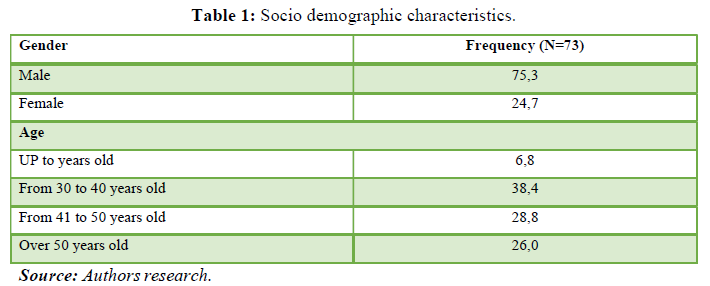

It is noticed that there are more men (75%) among the owners of catering facilities, while every fourth person is female.
Observed by age, it can be stated that most respondents are in the middle age - 38% are between 31 and 40 years old, and 29% of them are between 41 and 50 years old. About a quarter of the respondents are older than 50, while the smallest share is younger than 30 - 7% (Figure 1).
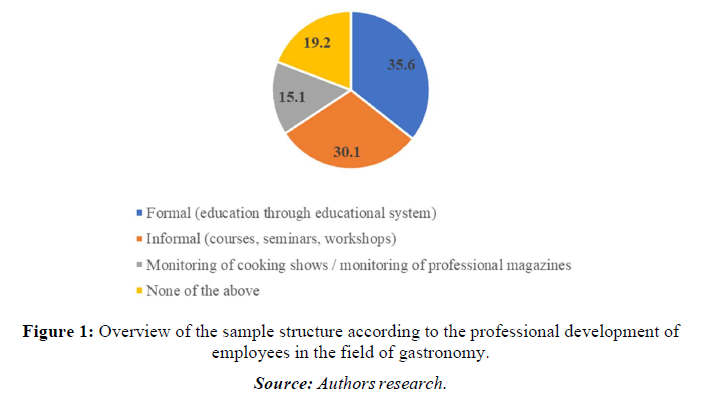

Just over a third of respondents (36%) state that employees in their facilities have and attend formal forms of training, while 30% state that the choice of employees is informal forms of professional training - courses, seminars, workshops. About 15% of respondents claim that employees in the restaurant, they educate by following cooking shows, as well as professional magazines. As many as one-fifth of the respondents chose the answer "none of the above", so we can assume that the employees in their restaurants are not interested in professional development (Figure 2).
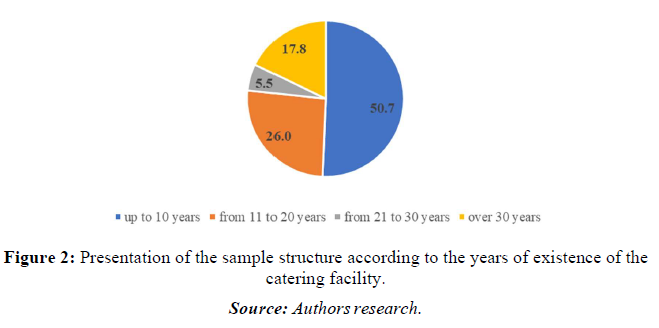

Half of the catering establishments whose owners were surveyed have existed for less than 10 years, and 26% have been operating for 11 to 20 years. About 5% of restaurants operate between the ages of 21 and 30, and about 18% are those who have been serving guests for over 30 years (Figure 3).
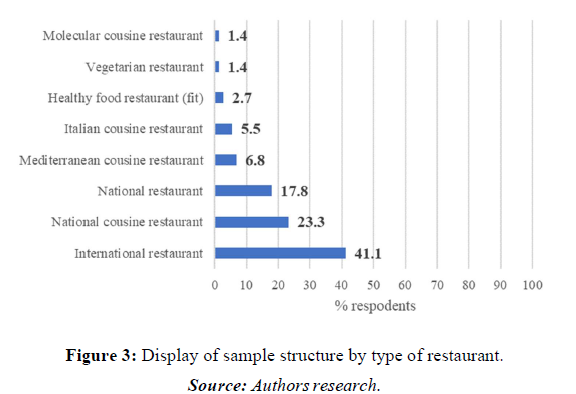
The dominant position in the sample consists of international restaurants (41%), local cuisine restaurants (23%) and national restaurants (18%). About 7% of restaurants offer Mediterranean cuisine, about 5% are Italian, and 3% are healthy food restaurants. The share of vegetarians and molecular cuisine restaurants is insignificant.
PRESENTATION OF RESEARCH RESULTS
Below is an overview of the respondents' answers to questions about modern trends in gastronomy. The questions were mostly closed, while two were open and the respondents formulated their answer to them. The mentioned issues were qualitatively analyzed (Figure 4).
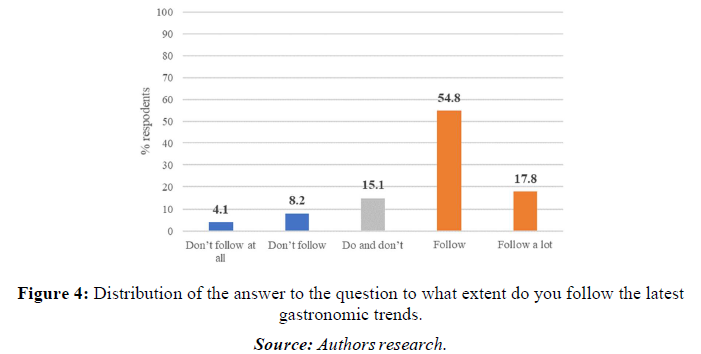

It is a positive finding that respondents generally claim to follow gastronomic trends - just over half of restaurant owners claim to follow trends, and about 18% do so to a large extent. About 15% of respondents state that they follow trends moderately, not at all, while about 12% of them do not follow gastronomic trends (Figure 5).
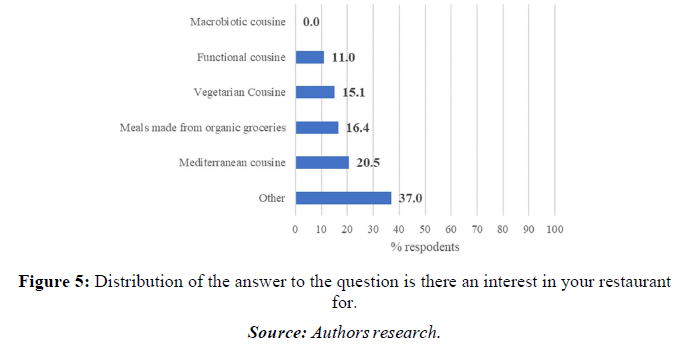

When asked which kitchen they are interested in in their restaurant, the largest percentage (37%) of respondents did not opt for any of the offered answers, which means that visitors to their restaurants are not interested in these specific cuisines. One-fifth of respondents believe that there is interest in Mediterranean cuisine, and about 15% state that guests want dishes prepared from organic foods or vegetarian dishes. 11% of respondents opted for a functional kitchen, while no restaurant owner thinks that guests are interested in macrobiotic cuisine (Figure 6).
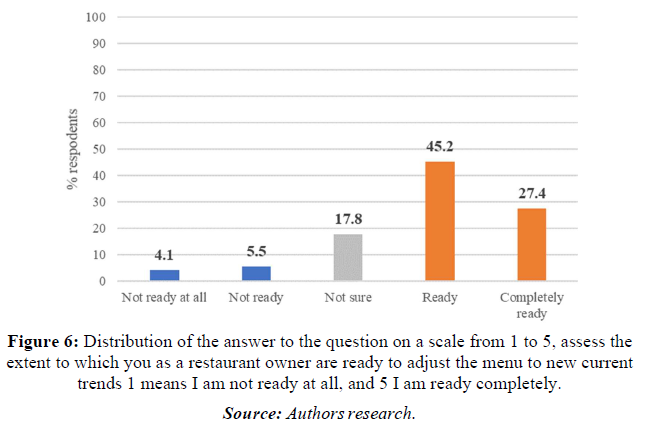

Respondents were able to assess their willingness to adjust the menu to new trends on a five-point scale, and the majority expressed readiness - 27% in full, while 45% said they were ready for such a move. About 18% of respondents are undecided on this issue, while a total of 10% of them are insufficiently ready to adapt the menu to gastronomic trends (Figure 7).
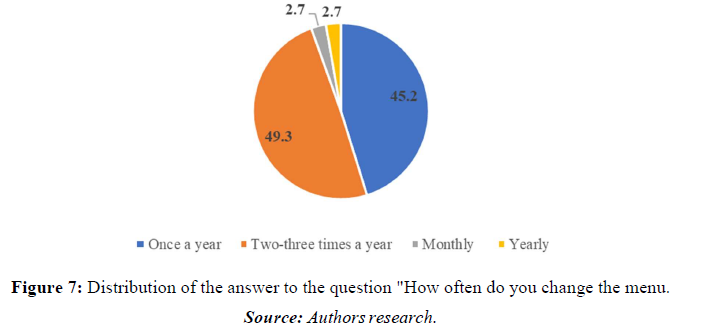

Restaurant owners who participated in the survey change the menu once (45%) or two to three times a year, which makes up half of them. The number of caterers who change the menu in their restaurants more often is negligible.
Respondents will have the opportunity to state how they communicate with guests regarding the offer of new dishes on the menu, and how they comment on the reactions of restaurant visitors to new dishes. A total of 67 respondents answered this question. Their responses were analyzed and qualitatively processed. The majority of respondents (37) state that the guests are very satisfied with the new dishes, enthusiastic and prone to praise, while 17 restaurant owners pointed out that they are always grateful for the comments and that they respect and analyze the views of the guests. Eight respondents state that their guests are very willing to try something new, while six state that their menu is mostly standard, as well as that their guests are not in the mood for gastronomic novelties.
Below are some of the respondents’ comments that illustrate how restaurant owners communicate with guests regarding the offer of new dishes on the menu.
“Guests are always interested in trying new dishes on the menu. We change the menu 4 to 5 times a year. We keep the old dishes that are often ordered and add new ones depending on the seasonal ingredients, since the menu is based on fresh ingredients”.
“They are not very enthusiastic. As a restaurant that has existed for almost 200 years, we are recognizable by our local cuisine”.
“Quality is less and less praised, the crucial thing for positive reactions is, unfortunately, painting, packaging and marketing which by default means a low-quality, unhealthy product”. It mainly comes down to explaining the composition of new dishes (Figure 8).
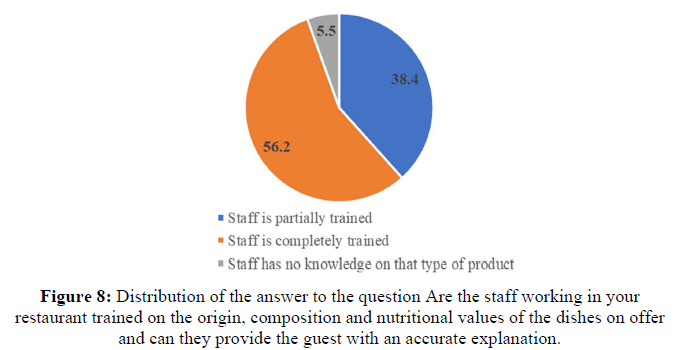

Slightly more than half of restaurant owners believe that their staff is fully trained on the origin, composition and nutritional value of the dishes on offer and can provide the guest with an accurate explanation, while 38% claim that employees are partially trained to do so. Only 5% of respondents state that the staff has no knowledge about this type of food (Figure 9).
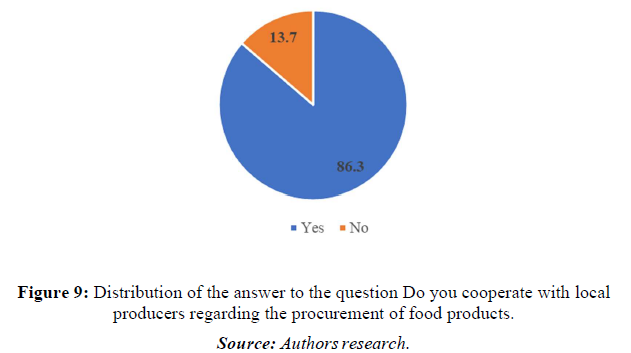

The majority of restaurant owners cooperate with local producers in order to procure food products, while 14% of them claim that they do not achieve this form of cooperation (Figure 10).
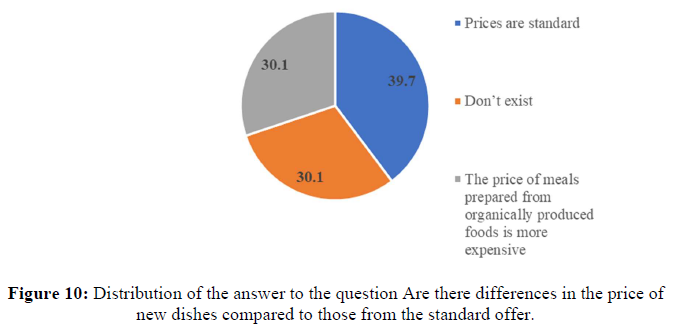

Regarding the relationship between the prices of "new" dishes and dishes from the standard offer, the opinions of restaurant owners are quite divided. About 40% of them claim that the prices are standard, 30% that there is no difference in price, while the same percentage of respondents’ state that there are differences, in the sense that dishes prepared from organic foods are more expensive (Figure 11).
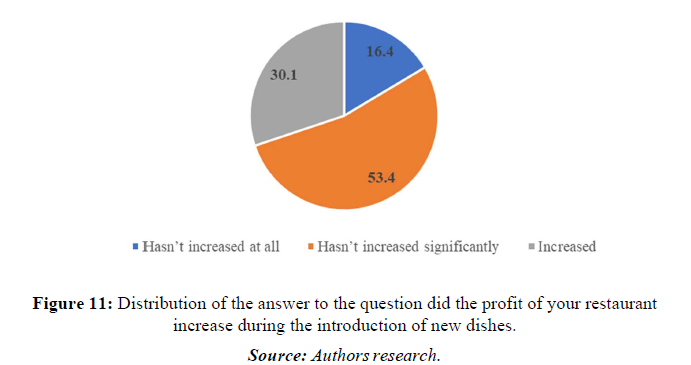
Half of the respondents believe that after the introduction of new dishes, the profit of the restaurant did not increase significantly, and 16% of them state that there was no increase in profit at all. Still, 30% of restaurant owners claim that profits increase when changing menus (Figure 12).
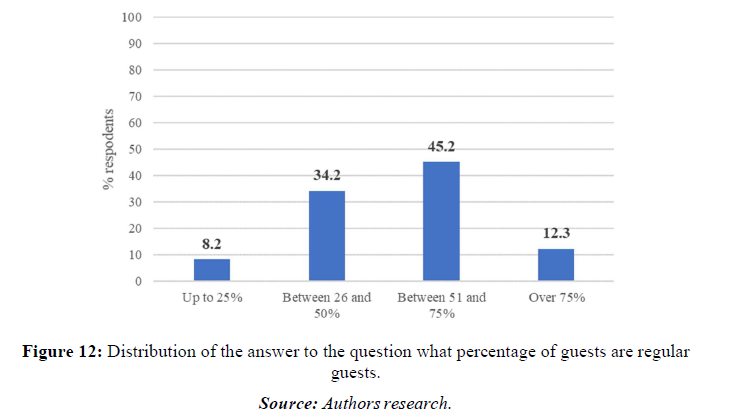

The restaurants that were the subject of the research are dominated by so-called regular guests - 12% of restaurants have the majority of regular guests (more than 75%), while almost every other restaurant has 50 to 75% of regular visitors. One third of restaurants are visited by 26 to 50% of regular customers, and only 8% of restaurants have very dynamic and diverse visitors, with less than 25% of those who come constantly (Figure 13).
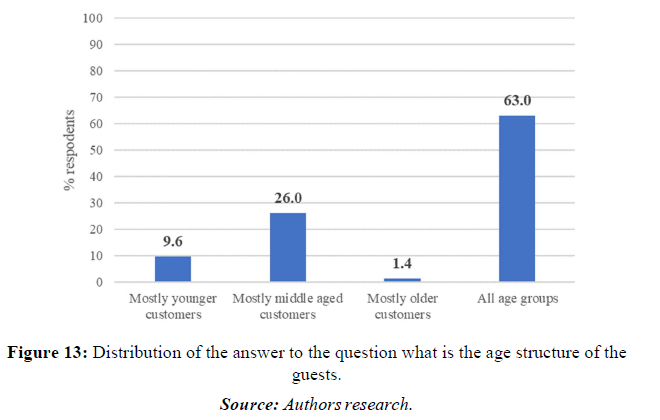

In terms of the age structure of restaurant visitors, most age groups (63%) are represented by all age groups, while every fourth restaurant is mostly visited by middle-aged customers, and every tenth is dominated by the younger population (Figure 14).
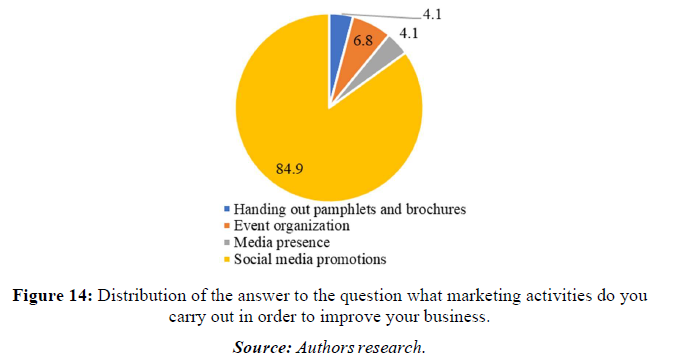

Restaurant owners are almost unanimous in promoting their business on social media, as 85% of them do. About 7% of them organize events in order to improve their business, while other marketing activities are carried out by 4% of respondents - distribution of brochures and publications, as well as presence in the media (Figure 15).
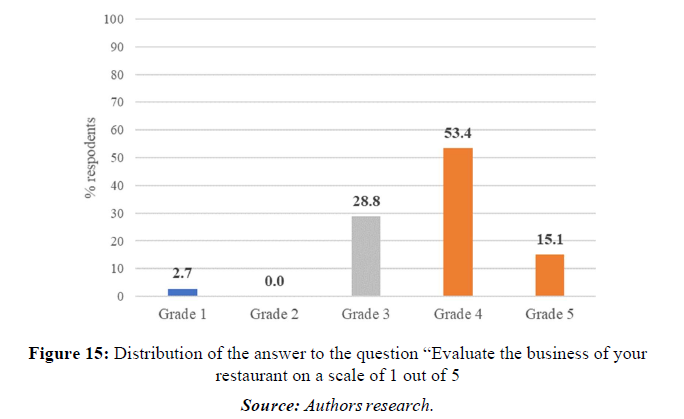

Every second respondent evaluates the business of their restaurant with a grade of 4, and 15% assigns the highest grade. Almost 30% of restaurant owners rate the business of the facility they manage with a three, while a negligible number of respondents gave lower grades. It can be concluded that the respondents are generally satisfied with the business, but that most of them have room for improvement and improvement of work.
Restaurant owners were asked to indicate in which direction they are thinking when it comes to introducing novelties to the restaurant. A total of 67 respondents answered the question. Their answers were qualitatively processed and categorized, with some respondents mentioning more than one category. The largest number of respondents (24) plan to develop restaurants in the direction of various innovations in the menu and constant improvement of the kitchen, as well as improving communication with guests, and harmonization with their requirements and wishes (11). Seven respondents stated that they would introduce innovations in line with world gastronomic trends, six planned to develop menus in the direction of organic foods, and five of them opted for the introduction of vegan cuisine. Two respondents are considering engaging in marketing and social media.
A total of 18 respondents did not provide a specific answer to the question of how they see their restaurant in the future - 11 of them are still thinking about it and currently do not have clearly defined plans, while seven respondents believe that much depends on the pandemic situation.
Below are some of the respondents' comments.
“Healthy, organic and first-class foods. Natural, tidy and homely ambience. Top selection of local wines. New standards in communication and cooperation."
“Every week a rotation of some authentic dishes from all over the world. Of course, dishes that fit into our concept of work, our possibilities and we follow the needs of our guests!”
“Every day we strive to raise business to a higher level, both with food and wine, and with service. Our business is based on 4 pillars: food, wine, ambience and service".
Comparison of respondents by gender in terms of assessment of restaurant business
In order to examine the differences in the average ratings of restaurant business between men and women, a t-test for independent samples was conducted (Table 2).
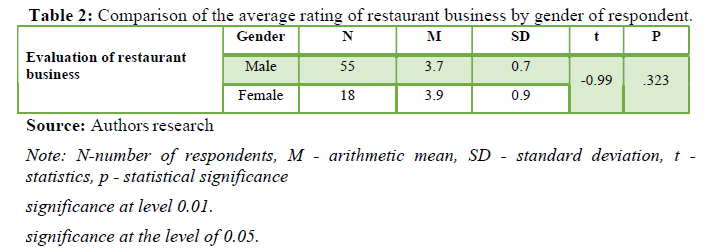

The results of the t-test of independent samples show that there are no statistically significant differences in the assessment of restaurant business between men and women, (t (71) = -0.991, p = .323). Female respondents on average rate the business of their restaurant with a score of 3.9, and respondents with a score of 3.7.
Comparison of respondents of different ages in terms of assessing the restaurant business
In order to examine the differences in the average ratings of restaurant business between respondents of different years, a one-factor analysis of variance was conducted. For the purposes of conducting the analysis (and due to the small number of respondents younger than 30 years), the age variable was recoded and the subjects were grouped into three categories: age up to 40 years, from 41 to 50 years and over 50 years (Table 3).


The results of the ANOVA test indicate that there are no statistically significant differences in terms of the average rating of restaurant business between respondents of different ages (F (2.70) = 0.073, p = .930).
Relationship between the degree of monitoring gastronomic trends and the willingness of respondents to adjust the menu with the assessment of restaurant business
In order to determine the correlation in terms of how much the respondents follow the gastronomic trends and adjust the menu with how they evaluate the business of the restaurant, a correlation analysis was conducted (Table 4).
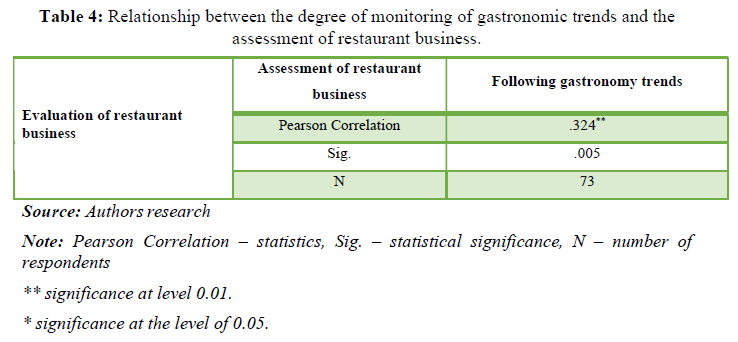

The results of Pearson's correlation indicate that there is a statistically significant positive correlation between the degree of monitoring of gastronomic trends and the assessment of restaurant business (r (71) = .324, p = .005). The connection is of medium strength and indicates that the more respondents are more inclined to follow the trends in gastronomy, the more positively they evaluate the business of their restaurant (Table 5).
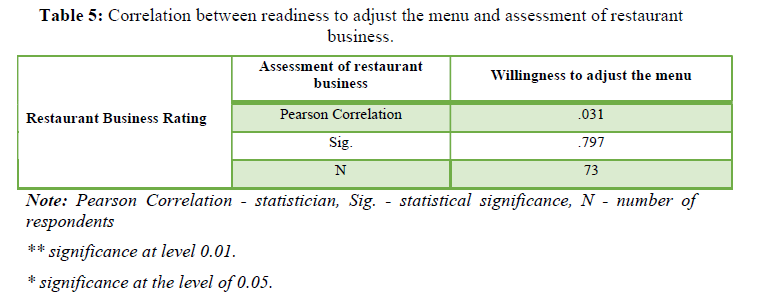
The results of Pearson's correlation indicate that there is no statistically significant correlation between the willingness of restaurant owners to adjust the menu and the evaluation of restaurant operations (r (71) = .031, p = .797)).
CONCLUSION
At the global level, tourism is developing in the direction of regional redistribution, ie restructuring of tourist movements towards new destinations. In that sense, the division into classic receptive and initiative tourist countries is increasingly difficult to maintain, given that the volume of tourist demand tends to increase constantly. The inclusion of new strata of the population from all over the world in tourist movements complicates the economic, ethno-sociological, cultural and psychological structure of demand. All modern changes in the world are reflected directly or indirectly on changes in world tourism. Tourism has been and will remain the leading indicator of globalization. In order to become such a process, to provide every man with hedonistic demands for rest, recreation and entertainment, he encounters great problems. Increasingly, those problems that tourism cannot actively influence stand out, because these processes are faster and more concrete in pursuing the interests of global capital. Demographic trends in the world, the rapid growth of science, technology, as well as the distribution and change of information condition the regional redistribution of world tourism. New methods of forming the tourist offer and demand, creating a new, flexible and quickly acceptable tourist product, as well as experiencing the world at home, condition that world tourism enters a risky phase.
Gastro tourism is a form of tourism that greatly affects the overall satisfaction of tourists to a tourist destination for the reason that food is an integral and indispensable part of every tourist trip. Today, gastronomy is trying to turn into a tourist attraction to attract tourists and create a brand of gastronomic destination. All world cuisines are different and stand out in some way, and at the same time that diversity today encourages tourists to try something new. New trends in nutrition indicate changes that have taken place in a social and technological sense that have led to changes in lifestyle. People are increasingly taking care of their health and adapting their food to this trend. The problems faced by gastrotourism are insufficient information and knowledge about new trends in gastronomy and insufficient education of restaurant staff about new culinary techniques to be able to create menus in accordance with these new trends. In recent years, gastrotourism has been growing exponentially from year to year, which shows how tourists have recognized this form of selective tourism. The trend of gastrotourism development has been recognized by leading gastronomic destinations such as France, Spain, Italy and Mexico, whose cuisines are known around the world. These countries consider gastrotourism a special segment of tourist demand and within them the tourist offer has organized tours that allow tourists to taste and get acquainted with their specialties, traditions and customs. It is inevitable, therefore, that the offer, whose base is the hotel industry, is adjusted to the demand, not only in the preparatory phase of its creation, but also in the phase of functioning. Demand-side changes are rapid and difficult to predict. The needs, desires and requirements of different categories of users dictate new trends in tourism, i.e., new forms of tourist movements. Motives of movement are increasingly conditioned by socio-psychological and cultural factors.
- Bakan, R. (2015). Modern trends in nutrition and their impact on the catering kitchen. Practical Management: A Professional Journal of Management Theory and Practice 6(1), 105-110.
- Barjaktarović, D., & Knežević, M. (2015). Future directions of restoration business development. Hotellink.
- Birch, D., & Memery, J. (2020). Tourists, local food and the intention behaviour gap. Journal of Hospitality and Tourism Management 43, 53-61.
- Božić, A., & Đurović, M. (2019). Molecular gastronomy–new trend in restaurant business. Knowledge International Journal 30(6), 1785-1790.
- Damjanović, A., & Ristić, Z. (2017). Contemporary trends influencing the choice of tourist destination. Dositej College of Academic Studies, Belgrade.
- Drljević O. (2016). Restaurant business management in modern market conditions. (Doctoral dissertation, University Singidunum).
- Drpić, K., & Vukman, M. (2014). Gastronomy as an important part of the tourist offer in Croatia. Practical management: a professional journal for management theory and practice 5(1), 62-67.
- Dugi, V. (2017). Gastrotourism trends in Croatia and the world Doctoral dissertation, Polytechnic of Međimurje in Čakovec.
- Gordin, V., Trabskaya, J., & Zelenskaya, E. (2016). The role of hotel restaurants in gastronomic place branding. International Journal of Culture, Tourism and Hospitality Research.
- Jahan, I., Bhuiyan, K. H., Rahman, S., Bipasha, M. S., & Zayed, N. M. (2020). Factors Influencing Consumers Attitude Toward Techno Marketing an Empirical Analysis on Restaurant Businesses in Bangladesh. International Journal of Management 11(8).
- Janković, I., Ćirić, M., & Vujasinović, V. (2020). The influence of authentic food on the choice of tourist destination. Bizinfo Blace 11(2), 81-92.
- Kisić, I. (2014). Introduction to organic farming. Zagreb Faculty of Agriculture University of Zagreb.
- Kowalczyk, A. (2020). New Trends in Gastronomy in the Context of the Urban Space Introduction to Part III. In Gastronomy and Urban Space 263-271.
- Mak, A. H., Lumbers, M., & Eves, A. (2012). Globalisation and food consumption in tourism. Annals of tourism research 39(1), 171-196.
- Obrenović, D., Kalenjuk, B., Radivojević, G., & Gašparovski, G. (2019). Molecular gastronomy as an important segment of modern gastronomy in the catering of Serbia. Turistc business (24), 15-21.
- Rojo, M. L., Rodríguez Gaztelumendi, A., Pazos, Á., & Díaz, Á. (2012). Differential adaptive changes on serotonin and noradrenaline transporters in a rat model of peripheral neuropathic pain. Neuroscience letters, 515(2), 181-186.
- Skryl, T., Gregoric, M., & Dugi, V. (2018). Culinary trends in the Republic of Croatia as part of gastro tourism development. European Research Studies Journal 21(3), 465-475.
- Socha Dietrich, K., & Dumont, J. C. (2021). International migration and movement of doctors to and within OECD countries Developments in countries of destination and impact on countries of origin.
- Tasić, J. (2018). Geographical and economic performance of organic agriculture and its impact on the stability of gastronomy tourism in Serbia. Oditor 38.
- Terrier, L., & Jaquinet, A. L. (2016). Food wine pairing suggestions as a risk reduction strategy reducing risk and increasing wine by the glass sales in the context of a Swiss restaurant. Psychological reports 119(1), 174-180.
- Tešanović, D. (2016). Basics of gastronomy for managers. Novi Sad: Faculty of Science, University of Novi Sad.
- Vargas Sánchez, A., & Lopez Guzman, T. (2015). Contemporary management and innovation Learning from the gastronomy sector. Journal of Food Agriculture and Environment 13(2), 32-38.
















